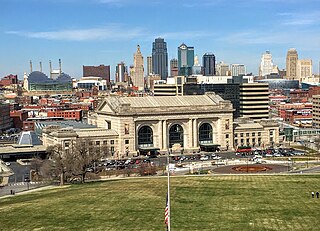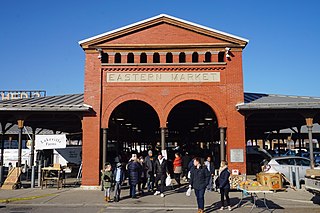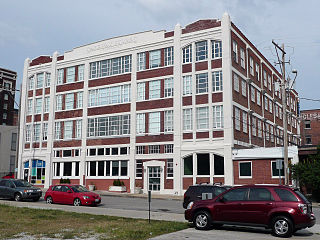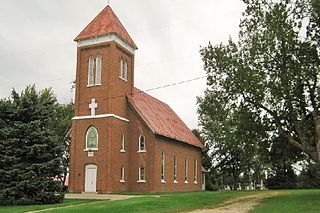Related Research Articles

Bonne Terre is a city in St. Francois County, Missouri, United States with a population of 6,864 at the 2010 census. Situated in the Southeast Missouri Lead District, lead mining shaped the history and character of the area from the earliest French settlers in the 1720´s until today, even though Bonne Terre Mine established by St. Joseph lead mining company in 1864 closed in 1962. Mine tailing piles eroded, and contaminated the area as dust, posing residential hazards or were washed into the Big River. Only in 1992, the Bonne Terre Mine Tailings Site was listed as a Superfund Site; as of 2022 remediation is still ongoing.

Florissant is a city in St. Louis County, Missouri, within Greater St. Louis. It is a middle-class, second-ring northern suburb of St. Louis. Based on the 2020 United States census, the city had a total population of 52,533.

Hillsdale is a town in Columbia County, New York, near Hudson, New York and Great Barrington, Massachusetts. State routes 22 and 23 intersect near the town center, which is listed on the National Register of Historic Places. The town has several restaurants and a general store, among other businesses. Hillsdale is known for its hilly landscape and is near Bash Bish Falls, Taconic State Park, and the Catamount ski area. The Harlem Valley Rail Trail, a 26-mile bike path in two sections, is located not far from the intersection of routes 22 and 23.

St. Joseph is a city in Andrew and Buchanan counties and the county seat of Buchanan County, Missouri, United States. Located on the Missouri River, it is the principal city of the St. Joseph Metropolitan Statistical Area, which includes Buchanan, Andrew, and DeKalb counties in Missouri and Doniphan County, Kansas. As of the 2020 census, St. Joseph had a total population of 72,473, making it the eighth largest city in the state, and the third largest in Northwest Missouri. St. Joseph is located roughly thirty miles north of the Kansas City, Missouri, city limits and approximately 125 miles (201 km) south of Omaha, Nebraska.

Downtown Kansas City is the central business district (CBD) of Kansas City, Missouri and the Kansas City metropolitan area which contains 3.8% of the areas employment. It is between the Missouri River in the north, to 31st Street in the south; and from the Kansas–Missouri state line eastward to Bruce R. Watkins Drive as defined by the Downtown Council of Kansas City; the 2010 Greater Downtown Area Plan formulated by the City of Kansas City defines the Greater Downtown Area to be the city limits of North Kansas City and Missouri to the north, the Kansas–Missouri state line to the west, 31st Street to the south and Woodland Avenue to the east. However, the definition used by the Downtown Council is the most commonly accepted.
America's 11 Most Endangered Places or America's 11 Most Endangered Historic Places is a list of places in the United States that the National Trust for Historic Preservation considers the most endangered. It aims to inspire Americans to preserve examples of architectural and cultural heritage that could be "relegated to the dustbins of history" without intervention.

Downtown Omaha is the central business, government and social core of the Omaha-Council Bluffs metropolitan area, U.S. state of Nebraska. The boundaries are Omaha's 20th Street on the west to the Missouri River on the east and the centerline of Leavenworth Street on the south to the centerline of Chicago Street on the north, also including the CHI Health Center Omaha. Downtown sits on the Missouri River, with commanding views from the tallest skyscrapers.

New Market, as it was originally known, and later also known as Head HouseMarket and Second Street Market, is an historic street market which is located on South 2nd Street between Pine and Lombard Streets in the Society Hill neighborhood of Philadelphia, Pennsylvania. With a history dating to 1745, it is one of the oldest surviving market buildings of its type in the nation.

The Lowertown Historic District is a historic district in the Lowertown neighborhood of Saint Paul, Minnesota, United States. This 16-block warehouse and wholesaling district comprises 37 contributing properties built 1870s–1920. It was listed on the National Register of Historic Places in 1983 for the significance of its river and rail connections, economic impact, architecture, and urban planning. Lowertown was originally the lower landing on the Mississippi River; the first port of access to the Twin Cities. Several warehouse, railroad, banking, and distribution buildings served the entire Upper Midwest from 1880 to 1920. A significant concentration of these buildings survive, unified by similar architectural styles and construction materials. Many were designed by the city's most prestigious architects, including Cass Gilbert and Clarence H. Johnston Sr.

Eastern Market is a commercial district in Detroit, Michigan. It is located approximately one mile (1.6 km) northeast of the city's downtown and is bordered on the south by Gratiot Avenue, the north by Mack Avenue, the east by St. Aubin Street, and the west by Interstate 75. It is sometimes referred to as the “Little Italy” of Detroit, although the Italian community has no tight-knit ethnic neighborhood present-day. The district was designated a Michigan State Historic Site in 1974 and listed on the National Register of Historic Places in 1978; the district's boundary was increased in 2007. The Eastern Market is located on the city's central east side near St. Joseph Roman Catholic Church and the Lafayette Park neighborhood. The market was transferred from city management in 2006, and now operates through a public-private partnership with the Eastern Market Corporation. Eastern Market is the largest historic public market district in the United States, and the Eastern Market farmer's distribution center is the largest open-air flowerbed market in the United States and has more than 150 foods and specialty businesses. On Saturdays, about 45,000 people shop the city's historic Eastern Market.

The Safeway Stores Office and Warehouse Building is a historic building near downtown Kansas City, Missouri. The building was designed by Kansas City architects Archer and Gloyd and was built by local contractor J. H. Thompson in 1929. It served as Safeway's regional produce and canned goods warehouse, as well as the regional headquarters for the chain. The warehouse served a region extending from Topeka, Kansas in the west to St. Joseph, Missouri in the north, Columbia, Missouri in the east to Joplin, Missouri in the south.

There are 75 properties listed on the National Register of Historic Places in Albany, New York, United States. Six are additionally designated as National Historic Landmarks (NHLs), the most of any city in the state after New York City. Another 14 are historic districts, for which 20 of the listings are also contributing properties. Two properties, both buildings, that had been listed in the past but have since been demolished have been delisted; one building that is also no longer extant remains listed.

St. Joseph's Catholic Church is a former parish of the Diocese of Davenport. The church is located in Dallas township in rural Marion County, Iowa, United States. It was part of the now defunct village of Bauer. The closest communities are Melcher-Dallas and Lacona. The church building still stands and together with the adjacent cemetery comprises an historic district listed on the National Register of Historic Places.

Edmond J. Eckel was an architect in practice in St. Joseph, Missouri, from 1872 until his death in 1934. In 1880 he was the founder of Eckel & Mann, later Eckel & Aldrich and Brunner & Brunner, which was the oldest architectural firm in Missouri prior to its eventual dissolution in 1999.

The German-American Bank Building is a historic bank building located at St. Joseph, Missouri. It was built in 1889, and is a six-story, rectangular brick building designed in the Richardsonian Romanesque style with added Beaux-Arts detailing.. The bank originally was created to provide service to the large number of German-speaking citizens in the region. In 1918 it was renamed the American National Bank. Later, it became First Federal Savings and Loan.

St. Joseph's Commerce and Banking Historic District is a national historic district located at St. Joseph, Missouri. The district encompasses 39 contributing buildings in the central business district of St. Joseph. It developed between about 1859 and 1950, and includes representative examples of Italianate, Classical Revival, and Streamline Moderne style architecture. Located in the district are the separately listed German-American Bank Building, Corby-Forsee Building, Missouri Theater and Missouri Theater Building, and Missouri Valley Trust Company Historic District. Other notable buildings include the Ballinger Building (1889), Commerce Building, First National Bank of St. Joseph, Lehman's, Plymouth Building (1908), and the United Building (1917-1918) by the architecture firm of Eckel & Aldrich.

Missouri Valley Trust Company Historic District, formerly known as the Market Square Historic District, is a national historic district located at St. Joseph, Missouri. The district encompasses six contributing buildings in the central business district of St. Joseph. It developed between about 1859 and the 1860s, and includes representative examples of Renaissance Revival style architecture. The primary building is the Bank of the State of Missouri (1859).

The McGregor Commercial Historic District is a nationally recognized historic district located in McGregor, Iowa, United States. It was listed on the National Register of Historic Places in 2002. At the time of its nomination the district consisted of 60 resources, including 51 contributing buildings, one contributing site, one contributing structure, and seven noncontributing buildings. Unlike most river towns in Iowa the central business district does not follow along the Mississippi River, but moves away from it. It is linear in shape, following Main Street, which runs from the southwest to the northeast in a narrow valley between two 400-foot (120 m) bluffs. The narrow valley ends at the river.

The Missouri Lumber and Mining Company (MLM) was a large timber corporation with headquarters and primary operations in southeast Missouri. The company was formed by Pennsylvania lumbermen who were eager to exploit the untapped timber resources of the Missouri Ozarks to supply lumber, primarily used in construction, to meet the demand of U.S. westward expansion. Its primary operations were centered in Grandin, a company town it built starting c. 1888. The lumber mill there grew to be the largest in the country at the turn of the century and Grandin's population peaked around 2,500 to 3,000. As the timber resources were exhausted, the company had to abandon Grandin around 1910. It continued timber harvesting in other parts of Missouri for another decade. While some of the buildings in Grandin were relocated, many of the remaining buildings were listed on the National Register of Historic Places in 1980 as part of the state's historic preservation plan which considered the MLM a significant technological and economic contributor to Missouri.
References
- 1 2 "National Register Information System". National Register of Historic Places . National Park Service. July 9, 2010.
- ↑ M. Patricia Holmes (January 1972). "National Register of Historic Places Inventory Nomination Form: Missouri Valley Trust Company Historic District" (PDF). Missouri Department of Natural Resources. Retrieved September 1, 2016.
- ↑ Historic Market Square

